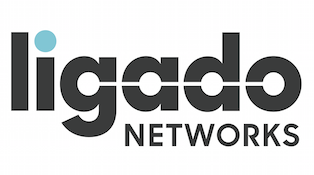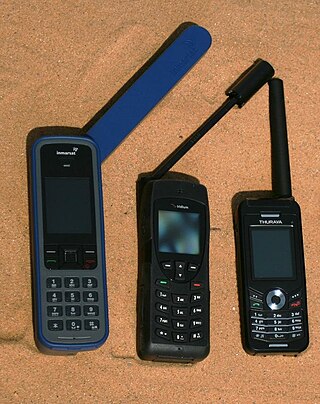Related Research Articles

Ultra high frequency (UHF) is the ITU designation for radio frequencies in the range between 300 megahertz (MHz) and 3 gigahertz (GHz), also known as the decimetre band as the wavelengths range from one meter to one tenth of a meter. Radio waves with frequencies above the UHF band fall into the super-high frequency (SHF) or microwave frequency range. Lower frequency signals fall into the VHF or lower bands. UHF radio waves propagate mainly by line of sight; they are blocked by hills and large buildings although the transmission through building walls is strong enough for indoor reception. They are used for television broadcasting, cell phones, satellite communication including GPS, personal radio services including Wi-Fi and Bluetooth, walkie-talkies, cordless phones, satellite phones, and numerous other applications.

XM Satellite Radio (XM) was one of the three satellite radio (SDARS) and online radio services in the United States and Canada, operated by Sirius XM Holdings. It provided pay-for-service radio, analogous to subscription cable television. Its service included 73 different music channels, 39 news, sports, talk and entertainment channels, 21 regional traffic and weather channels, and 23 play-by-play sports channels. XM channels were identified by Arbitron with the label "XM".

Wireless communication is the transfer of information (telecommunication) between two or more points without the use of an electrical conductor, optical fiber or other continuous guided medium for the transfer. The most common wireless technologies use radio waves. With radio waves, intended distances can be short, such as a few meters for Bluetooth or as far as millions of kilometers for deep-space radio communications. It encompasses various types of fixed, mobile, and portable applications, including two-way radios, cellular telephones, personal digital assistants (PDAs), and wireless networking. Other examples of applications of radio wireless technology include GPS units, garage door openers, wireless computer mouse, keyboards and headsets, headphones, radio receivers, satellite television, broadcast television and cordless telephones. Somewhat less common methods of achieving wireless communications involve other electromagnetic phenomena, such as light and magnetic or electric fields, or the use of sound.
Globalstar, Inc. is an American satellite communications company that operates a low Earth orbit (LEO) satellite constellation for satellite phone, low-speed data communications and earth observations. The Globalstar second-generation constellation consists of 25 low Earth orbiting (LEO) satellites.

The Hughes Aircraft Company was a major American aerospace and defense contractor founded on February 14, 1934 by Howard Hughes in Glendale, California, as a division of Hughes Tool Company. The company produced the Hughes H-4 Hercules aircraft, the atmospheric entry probe carried by the Galileo spacecraft, and the AIM-4 Falcon guided missile.

A satellite telephone, satellite phone or satphone is a type of mobile phone that connects to other phones or the telephone network by radio link through satellites orbiting the Earth instead of terrestrial cell sites, as cellphones do. Therefore, they can work in most geographic locations on the Earth's surface, as long as open sky and the line-of-sight between the phone and the satellite are provided. Depending on the architecture of a particular system, coverage may include the entire Earth or only specific regions. Satellite phones provide similar functionality to terrestrial mobile telephones; voice calling, text messaging, and low-bandwidth Internet access are supported through most systems. The advantage of a satellite phone is that it can be used in such regions where local terrestrial communication infrastructures, such as landline and cellular networks, are not available.

The history of mobile phones covers mobile communication devices that connect wirelessly to the public switched telephone network.
The Boeing Satellite Development Center is a major business unit of Boeing Defense, Space & Security. It brought together Boeing satellite operations with that of GM Hughes Electronics' Space and Communications division in El Segundo, California.
Pendrell Corporation is an intellectual property (IP) investment, advisory services and asset management firm. The company develops and implements strategies to acquire, commercialize, manage, divest and license IP. The company, formerly ICO Global Communications, is based in Kirkland, Washington.

PLDT, Inc., formerly known as the Philippine Long Distance Telephone Company, is a Philippine telecommunications, internet and digital service company.
Thuraya is a United Arab Emirates-based regional mobile-satellite service (MSS) provider. The company operates two geosynchronous satellites and provides telecommunications coverage in more than 161 countries in Europe, the Middle East, North, Central and East Africa, Asia and Australia. Thuraya's L-band network delivers voice and data services.
MSAT is a satellite-based mobile telephony service developed by the National Research Council Canada (NRC). Supported by a number of companies in the US and Canada, MSAT hosts a number of services, including the broadcast of CDGPS signals. The MSAT satellites were built by Hughes with a 3 kilowatt solar array power capacity and sufficient fuel for a design life of twelve years. TMI Communications of Canada referred to its MSAT satellite as MSAT-1, while American Mobile Satellite Consortium referred to its MSAT as AMSC-1, with each satellite providing backup for the other.

Inmarsat is a British satellite telecommunications company, offering global mobile services. It provides telephone and data services to users worldwide, via portable or mobile terminals which communicate with ground stations through fifteen geostationary telecommunications satellites.
Hughes Network Systems, LLC is a wholly owned subsidiary of EchoStar. It is headquartered in Germantown, Maryland and provides satellite internet service. HughesNet has over a million subscribers in the Americas in late 2023, down from 1.4 million in early 2022.
TerreStar Corporation (TSTR), formerly Motient Corp. and American Mobile Satellite Corp., was the controlling shareholder of TerreStar Networks Inc., TerreStar National Services, Inc. and TerreStar Global Ltd., and a shareholder of SkyTerra Communications.

Hughes Electronics Corporation was formed in 1985 when Hughes Aircraft was sold by the Howard Hughes Medical Institute to General Motors for $5.2 billion. Surviving parts of Hughes Electronics are today known as DirecTV Group, while the automotive divisions became Aptiv.
GEO-Mobile Radio Interface, better known as GMR, is an ETSI standard for satellite phones. The GMR standard is derived from the 3GPP-family terrestrial digital cellular standards and supports access to GSM/UMTS core networks. It is used by ACeS, ICO, Inmarsat, SkyTerra, TerreStar and Thuraya.
TerreStar Networks, a majority owned subsidiary of TerreStar Corporation (TSTR), is a next generation, wholesale mobile communications provider launching the first integrated satellite terrestrial service with the world's first satellite-terrestrial smartphone.

Ligado Networks, formerly known as LightSquared, is an American satellite communications company.

Mobile-satellite service is – according to Article 1.25 of the International Telecommunication Union's Radio Regulations – "A radiocommunication service
References
- ↑ "Huge: Hybrid satellite-LTE network launches under the name LightSquared". 20 July 2010.
- ↑ "LightSquared Gets SkyTerra 1 Satellite into Orbit".
- ↑ "Report". sec.gov. Retrieved 11 December 2023.
- ↑ "Motient Announces New Funding for Mobile Satellite Ventures Subsidiary. - Free Online Library". Archived from the original on 2012-10-22. Retrieved 2011-01-07.
- ↑ "ECFS".
- ↑ Name change notice skyterra.com [ permanent dead link ]
- ↑ Federal Communications Commission license
- ↑ "2005 Form 10-K, The DirecTV Group, Inc". U.S. Securities and Exchange Commission. March 10, 2006.
- ↑ "SkyTerra Communications Acquires Remaining Interest in Hughes Network Systems LLC from The DIRECTV Group". The DirecTV Group, Inc. January 3, 2006.
- ↑ "SkyTerra Communications Acquires Remaining Interest in Hughes Network Systems LLC from The DIRECTV Group". SkyTerra Communications, Inc. January 3, 2006. Archived from the original on February 15, 2011.
- ↑ "The Hughes Communications/SkyTerra Separation". Wikinvest. March 29, 2006. Archived from the original on 2011-07-22. Retrieved 2011-04-23.
- ↑ "TerreStar (TSTR) Sells Remaining Shares in SkyTerra for $123M".
- ↑ "Current Report".
- 1 2 "SkyTerra 1, 2 (MSV 1, 2, SA)".
- ↑ "Satellite Services - LightSquared". Archived from the original on 2013-02-02. Retrieved 2011-01-07.
- ↑ Drucker, Jesse (February 9, 2006). "As Satellite Firms Move to Add Cellular Service, Critics Cry Foul". The Wall Street Journal.
- ↑ MSV Moving Ahead With Second-Generation System Plans
- ↑ OnTheCommons.org | The Looting Continues Archived 2010-06-20 at the Wayback Machine
- ↑ patents
- ↑ "Satellite Services - LightSquared". Archived from the original on 2012-09-09. Retrieved 2010-11-28.
- ↑ Chris Bergin (2010). ILS Proton-M launches with SkyTerra 1 satellite . NASASpaceFlight.com. Retrieved November 14, 2010.
- ↑ "NASA - NSSDCA - Spacecraft - Details". nssdc.gsfc.nasa.gov. Retrieved 2024-04-23.
- ↑ Selding, Peter B. de (2010-12-14). "Boeing Finishes Deployment of Stuck SkyTerra 1 Antenna". SpaceNews. Retrieved 2024-04-23.